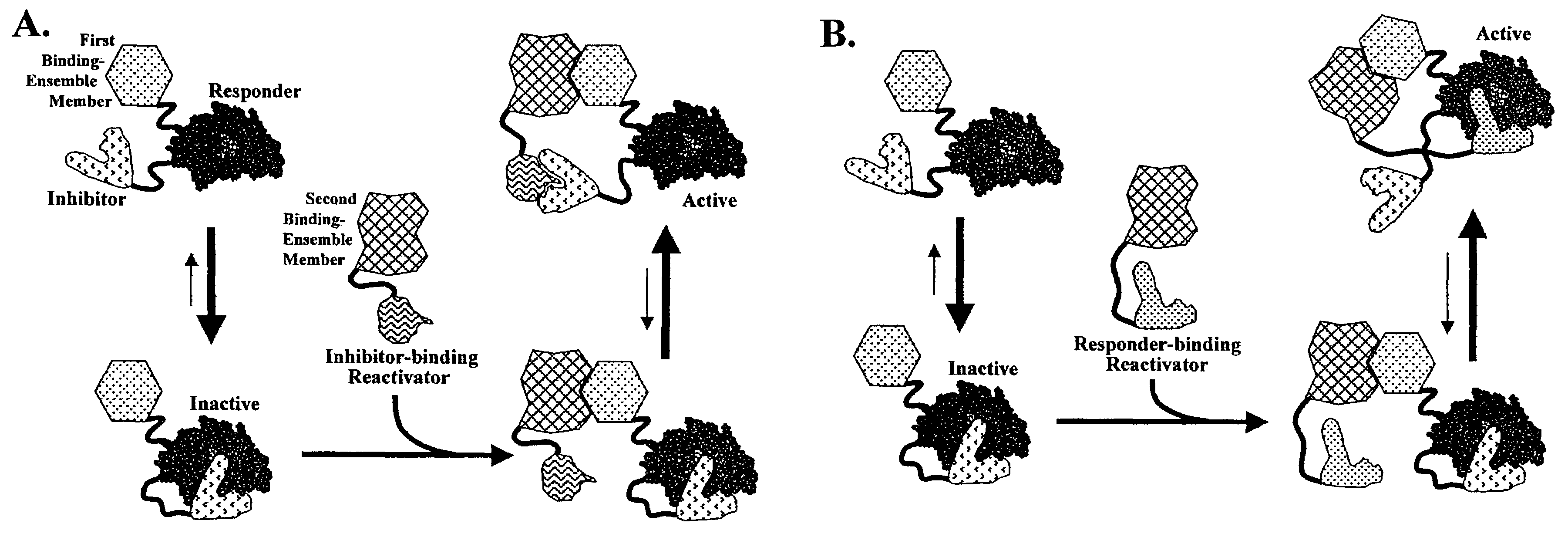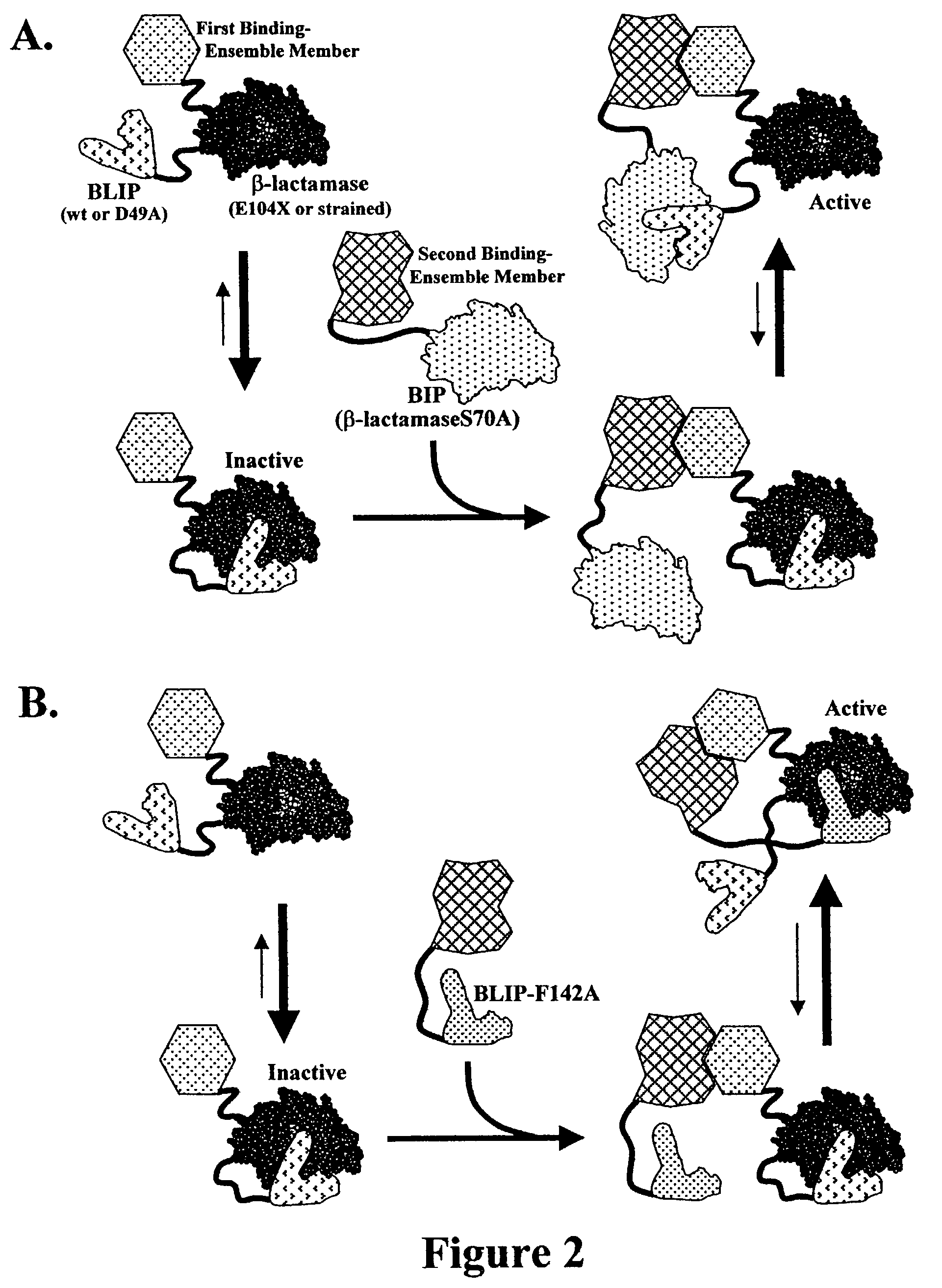Reactivation-based molecular interaction sensors
- Summary
- Abstract
- Description
- Claims
- Application Information
AI Technical Summary
Benefits of technology
Problems solved by technology
Method used
Image
Examples
example 1
Interaction-Mediated Reactivation of Cis-Inhibited β-Lactamase
[0169]This example demonstrates the basic functionality of the methods and systems of the invention for detecting molecular interactions and inhibitors thereof.
[0170]A model interaction was used to test the ability of reactivators, BIP (β-lactamase-S70A) and BLIP-F142A, to reactivate a β-lactamase responder which was strongly inhibited in cis by fusion to BLIP-D49A, when the reactivator and the cis-inhibited β-lactamase were brought together by the model interaction in E. coli cells. Further, the system was tested for competitive inhibition of the reactivation when the reactivating interaction was inhibited by one of the model interactors expressed from a second gene without a fusion partner. The model interaction was comprised of the leucine zipper helices of the c-fos and c-jun subunits of the AP-1 transcription factor (Karin et al., (1997) Curr Opin Cell Biol 9, 240-6). The c-fos helix was fused via a flexible linker t...
example 2
Antigen-Antibody Interaction-Mediated Reactivation of Cis-Inhibited β-Lactamase
[0178]This example demonstrates the utility of the invention for detection of antigen-antibody interactions, selection of antibodies against specific antigens, and affinity maturation of antibodies. Also, the ability of the system to detect free antigen molecules via a tri-molecular interaction is demonstrated. Finally, reactivation of β-lactamase by antigen-antibody interaction when the responder complex comprises non-covalent linkages is demonstrated.
[0179]The antibody used in this example was a mouse monoclonal raised against the extra-cellular domain of the human B-cell activation antigen CD40, and isolated by hybridoma technology. This antibody, designated HB15, had a Kd for CD40 of 7.6 nM, as determined by surface plasmon resonance (Fägerstam et al., (1992) J Chromatog 597: 397-410). A higher-affinity variant of this antibody was subsequently identified which contained two mutations in the third com...
example 3
Re-Activation of Cis-Inhibited β-Lactamase In Vitro by Antigen-Antibody Interaction.
[0191]This example demonstrates the ability of systems of the invention to function in vitro and to detect analytes of interest in biological specimens.
[0192]The system components described in Example 2, i.e., the CD40-BLIP-D49A-βlactamase fusion, and the fusions of anti-GST Fab, HB15, and HB15Y with BLIP-F142A (see FIG. 11, Tripartite Responder Fusion Expression Vector, and Reactivator Fusion Expression Vectors), were purified from suspension cultures, and then mixed in vitro with a chromogenic substrate to test for antibody-specific β-lactamase activation. Each of the fusion proteins was equipped with a carboxyl-terminal His6 tag for purification by immobilized metal ion affinity chromatography (IMAC; Janknecht et al. (1991) Proc Natl Acad Sci USA 88: 8972-6). Separate one-liter cultures of each construct in E. coli TOP10F′ cells (Invitrogen Corp., Carlsbad, Calif.) were grown to mid-log phase in 2...
PUM
| Property | Measurement | Unit |
|---|---|---|
| Temperature | aaaaa | aaaaa |
| Fraction | aaaaa | aaaaa |
| Density | aaaaa | aaaaa |
Abstract
Description
Claims
Application Information
 Login to View More
Login to View More - R&D
- Intellectual Property
- Life Sciences
- Materials
- Tech Scout
- Unparalleled Data Quality
- Higher Quality Content
- 60% Fewer Hallucinations
Browse by: Latest US Patents, China's latest patents, Technical Efficacy Thesaurus, Application Domain, Technology Topic, Popular Technical Reports.
© 2025 PatSnap. All rights reserved.Legal|Privacy policy|Modern Slavery Act Transparency Statement|Sitemap|About US| Contact US: help@patsnap.com



